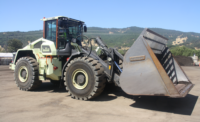
In an industry that is slowly embracing alternative energy for heavy equipment, John Deere's Construction & Forestry division has thrown its hat into the hybrid ring with its new 644K Hybrid wheel loader, which uses a diesel engine to power an electric drive system that burns up to 25% less fuel.
Last month, Deere invited ENR to test-drive the loader at its training facility in Coal Valley, Ill., near Deere's global headquarters in Moline. We ran both the 644K Hybrid and its non-hybrid counterpart in scenarios that simulated scooping, unloading and navigating a jobsite. It is Deere's first hybrid construction machine and, outside of the mining class, the market's first hybrid loader to go into production.
There are few differences between the two models. The hybrid version incorporates a power-electronics module—essentially a rugged box that serves as the nerve center for the hybrid power train—under the step just outside of the cab. "Beyond that stair on the machine, you would not know that it has a hybrid power train," says John Chesterman, product marketing manager for Deere loaders. A small hybrid decal is affixed to the rear cowling.
The other hybrid components are buried deep in the machine, though a brake resistor and the loader's 194-horsepower electric motor—along with three bright-orange wires—peek out from the steering-articulation joint. The machine's 6.8-liter diesel engine, with 229 hp, drives a hydraulic gear pump and electric generator, which powers the inboard motor. A simple three-speed transmission and conventional axles drive the wheels.
Deere's hybrid saves fuel by downsizing the diesel—the non-hybrid develops about the same horsepower but has 2.2 more liters of displacement—and running at a narrower speed range. We tried but failed to push the hybrid's tachometer higher than its stated peak of 1,800 rpm; however, we noticed no loss in performance. The non-hybrid lugs between 900 and 2,300 rpm, and the higher spikes in engine speed, coupled with parasitic losses from the torque-converter transmission, result in wasted fuel and slower operating cycles. Interestingly, both machines weigh about the same: roughly 20 tons.
One of the advantages of electric drive is that full power and torque are available throughout the engine's speed range. This translates into faster production and less guesswork for the operator, who usually hits the throttle pedal to push more hydraulic power into the bucket. It also means the generator-like engine may last longer—Deere predicts 20,000 or more hours is possible. Finally, the cab is about 50% quieter because the engine is not revving up and down all the time.
As expected, up-front costs are higher for the hybrid. Deere is pricing it at $53,325 more than the standard 644K, or about a 20% premium. Running at an average of 2,000 hours per year, Deere predicts the cost difference could pay back in four years. As the average idle time for a wheel loader is 30% to 40%, machines used in heavy-loading applications will pay back sooner, Deere says.
While some contractors may be hesitant to switch to hybrid, machine owners operating in government, power-utility, waste and other fleets "that place a high value on sustainability" are ordering the loader, which went into production in March, Chesterman says. A larger hybrid loader, based on Deere's 944K and incorporating four advanced electric motors, is set to launch next year.


Post a comment to this article
Report Abusive Comment